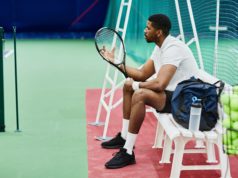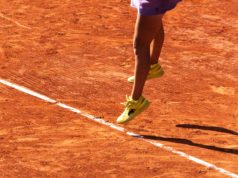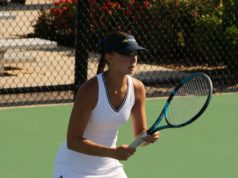By Ian Thompson, Director of Tennis, Carl E. Sanders Family YMCA at Buckhead
Poaching in doubles is one of the most effective ways to keep your opponents off their games because they must consider what you are doing at the net. The question I am asked most often from players is, “When should I poach?” There are numerous opinions for this tactic, and each tactic works well for certain groups. This article will focus on cues to watch for in your match to determine when to poach. One of the biggest things to consider is no matter how good you are at poaching, your partner will be half of the equation to get you involved. If they are not giving you the right balls to play, you will not be successful at poaching. So, talking over what you want to look for will allow your partner to understand the shots on which you want to poach.
I am not going to discuss the deep approach shot because any team that can lob the shot will stop the poaching immediately. If this is something that you look for when you play, then make sure to discuss it with your partner because it can be effective. But realize, any lob will render the poach completely useless. The three cues I will discuss are the low ball to the backhand, any shot more than two steps from the opponent, and balls lobbed over the opposing net player.
The low ball to the backhand
The first cue that I watch for is the low ball to the backhand because it will force the opponent to hit up on the ball. The backhand is harder to generate pace, so a lower ball means more time for you to get to the ball. The other reason the low backhand is a good option is that it is going to be difficult to get a lob over you off the backhand — one less shot you must worry about trying to cover. The backhand is a shot most people do not practice enough, so it can break down easier in tight situations. When you are playing right-handers, the backhand will be on the ad side wide and yes, that means a right-handed player will be moving to a backhand poach. Mentally, when a player poaches on the backhand side to end the point it shows that the player has a practiced and efficient poach. This means you will win more free points over time with this tactic. Make sure you are confident in the shot, so if you do not feel comfortable in your backhand poach, consider a different cue.
Any shot more than two steps from the opponent
The next cue is any shot that makes the opponent move more than two steps. Most players will have a tougher time getting into perfect position the more their footwork has to be precise in taking more steps. More time to get to the shot also could change the stress level on the opponent. They may overthink the ball they will hit or see whether you are moving to poach or faking it. While there will be some highlight shots with players on the run, the inconsistency of repeating these will heavily favor your team. Again, seeing the ball off to the backhand side could be more effective because it is usually the shot that will not have as much power. If someone is not a strong poacher, then going through the middle also could work with a drive. Again, talk with your partner and decide what you want to see.
Balls lobbed over the opposing net player
Finally, the lob over the net player can change how the match is going to go. Here is an example of why this can be so effective. How do you get to the backhand when the right-hand player is in the deuce court? The lob is the most effective and easiest way to get them over to the backhand and on the run. When you are playing, and you are having consistent rallies cross-court, the lob can be a way to change things. Again, do not change a winning plan. If you are winning, keep doing what you are doing until you must make a change. If you are losing, you need to adjust, and the lob is a good shot to throw into the mix. For the poacher, look for a weak and short lob, and make a strong overhead for a winner.
There is no perfect time to poach but discussing with your partner about what you are looking for on the poach can help the process. Your partner is vital in making sure you have opportunities to poach, and they need to know what cues will allow you to help them win the points. There are many cues other than those described here. Please discuss with your partner so you are both on the same page and work on it in practices. One of my former bosses, Jeff Chandley, had a perfect saying about the poach that “you should be on the hunt for the ball.” When you see your cue, it is happy hunting!




